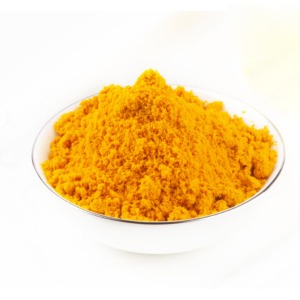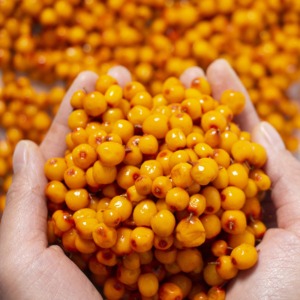Obesity is the accumulation of excess fatty tissue, accompanying the increase of body weight and fat deposition in the liver, causing corresponding metabolism dysfunction. Evidence showed that consuming foods rich in bioactive compounds, such as fruits and vegetables, could benefit anti-obesity and obesity-association metabolism diseases.
Our study showed that daily supplementation with seabuckthorn freeze-dried powder at 4.0 mg/(g.d. body weight) could significantly decrease body weight, Lee’s index, adipose tissue weight, liver weight, and other obesity-related indexes. Meanwhile, we also observed that seabuckthorn freeze-dried powder administration dramatically prevented the increase of serum TC, TG, and LDL-C induced by a high-fat diet.
 So, we concluded that a certain amount of intake of seabuckthorn freeze-dried powder could prevent obesity and obesity-related lipid metabolism disorders caused by a high-fat diet. Nevertheless, we also observed that the food intake and energy intake of the HSFP group were significantly lower than the HFD group. To determine whether weight loss is associated with reduced food intake, we calculated the food efficiency and energy efficiency ratios, representing the relationship between weight gain and food intake. We found that even if they eat the same high-calorie fat-rich foods, seabuckthorn intake could not only reduce food intake to prevent the development of obesity but also reduce the utilization efficiency of food and energy. Similar results showed in the dietary intervention of Phaseolus vulgaris extract, fresh angelica keiskei juice, and mulberry ethanol extract on obesity induced by a high-fat diet.
So, we concluded that a certain amount of intake of seabuckthorn freeze-dried powder could prevent obesity and obesity-related lipid metabolism disorders caused by a high-fat diet. Nevertheless, we also observed that the food intake and energy intake of the HSFP group were significantly lower than the HFD group. To determine whether weight loss is associated with reduced food intake, we calculated the food efficiency and energy efficiency ratios, representing the relationship between weight gain and food intake. We found that even if they eat the same high-calorie fat-rich foods, seabuckthorn intake could not only reduce food intake to prevent the development of obesity but also reduce the utilization efficiency of food and energy. Similar results showed in the dietary intervention of Phaseolus vulgaris extract, fresh angelica keiskei juice, and mulberry ethanol extract on obesity induced by a high-fat diet.
Generally, the excessive accumulation of fat in the body is closely related to lipid metabolism, including fat synthesis, mobilization, and decomposition. The liver and adipose tissue, as main metabolism places, has been noticed by a lot of researchers. After feeding, fat enters the small intestine, is hydrolyzed, and emulsified into tiny fat droplets combined with bile salts. Triglycerides are digested to form fatty acids and glycerol, among which the intestinal mucosa partly absorbs fatty acids, and the rest could be resynthesized into triglycerides. They then form into chylomicrons with proteins, cholesterol, and phospholipids. Formed chylomicrons are transported to tissue through the lymphatic system and blood, catalyzed by lipoprotein lipase to fatty acids and glycerol in the capillaries of the tissues during the stage.
Then, the fatty acids enter the liver and are used as substrates for β-oxidation or resynthesis of triglycerides. It is known that hepatic de-novo lipogenesis and fatty acid oxidation are the primary metabolic pathways that regulate hepatic lipid metabolism. During the metabolism, SREBP-1c and PPARα were key regulators in lipogenesis and fatty acid oxidation pathways, respectively. SREBP-1c, a transcription factor, is a critical regulator that stimulates fatty acid and triglyceride biosynthesis through the up-regulation of rate-limiting enzymes, such as FAS and ACC. ACC could catalyze Acetyl-CoA conversion to malonyl-CoA as a rate-limiting enzyme in the first step of fatty acid synthesis. Acetyl-coa and malonyl-CoA were synthesized to a long-chain fatty acid under the expression of SREBP-1c and FAS. PPARγ, as a transcription factor in adipogenesis, is involved in the accumulation of lipids droplets.
In the present study, we observed that seabuckthorn freeze-dried powder supplements inhibited lipid lipogenesis in the liver by down-regulating the over-expression of SREBP-1c, PPARγ, and ACC induced by a high-fat diet.
In addition, the catabolism of fatty acids is mainly fatty acid β-oxidation. PPARα, a ligand-activated nuclear hormone receptor, stimulates fatty acid oxidation by up-regulating downstream genes, such as ACOX and CPT1.
While seabuckthorn freeze-dried powder could enhance the expressions of PPARα, CPT1, and ACOX to speed up the oxidation of lipids, the process of lipid consumption begins with the activation of fatty acids into fatty acyl-CoA (ACOX), and the fatty acyl-CoA come into the mitochondria to β-oxidation under sufficient conditions of oxygen supply. ACOX is the rate-limiting enzyme of peroxidase fatty acid β-oxidation, and CPT1 is the rate-limiting enzyme of β-oxidation of fatty acids, which is determined as the speed of fatty acid oxidation.
Regarding research about preventing or improving obesity and obesity-related diseases, it was noted that supplementation with polyphenols, polysaccharides, or flavonoid-rich plants could ameliorate obesity symptoms by activating fatty acid β-oxidation or increasing lipid metabolism. For example, quercetin, resveratrol, kaempferol glycosides, and polysaccharides reduced the body weight gain and the accumulation of adipose tissue by down-regulating PPARγ and SREBP-1c expression and up-regulating PPARα expression. Our research confirmed that seabuckthorn freeze-dried powder could alleviate obesity-induced abnormal lipid metabolism, and it might be related to abundant bioactive substances like polyphenols, flavonoids, and polysaccharides.
Excess energy is stored in the form of triacylglycerols in adipose tissue. This study observed a significant increase in adipose tissue weight in the HFD group. After the treatment of seabuckthorn freeze-dried powder, the fatty tissue weight was significantly reduced, especially epididymal fat. In the fat synthesis period, except for PPAR-γ, FAS, and ACC genes, SCD1 also worked. SCD1 is a key regulatory gene that catalyzes the synthesis of monounsaturated fatty acids, and the expression of SCD1 is frequently used to characterize lipid deposition in adipose tissue. C/EBP-α, a transcription factor, is encoding for lipid differentiation.
Treatment of seabuckthorn freeze-dried powder could down-regulate the over-expression of PPAR-γ, ACC, and SCD1 induced by a high-fat diet, but no significant effect was observed on the expression of C/EBP-α compared with the HFD group.
In addition to fat synthesis and storage, lipolysis also occurs in adipose tissue owing to the homeostasis mechanism of body metabolism. As a key rate-limiting enzyme in the decomposition of triglycerides in adipose tissue, HSL is mainly expressed in adipose tissue, which can catalyze stored TG into free acids and glycerol, thereby improving animal fat abnormal deposition.
After seabuckthorn freeze-dried powder intervention, the expression of HSL significantly increased compared with the HFD group. Based on these results, we concluded that seabuckthorn freeze-dried powder plays a vital role in reducing fat accumulation and losing weight by suppressing the expression of synthetic and stored genes or enhancing the expression of decomposition genes. Anti-obesity effects of seabuckthorn freeze-dried powder could result from polyphenols, total sugar, acid, or dietary fiber.
Recent animal studies reported that some plants crammed with bioactive ingredients, such as bamboo-shaving, angelica keiskei, and citrus peel, reduced body weight gain and Lee’s index and ameliorated lipid metabolic disorders by altering the composition and structure of gut microbiota.
microbiota.
On this basis, we further investigated whether the beneficial effect of seabuckthorn freeze-dried powder on the improvement of obesity was associated with the changes in gut microbiota. Compared with the normal individual, high-fat diet consumption in the phylum level generally leads to an increase of the Firmicutes proportion or a decrease in the Bacteroidetes ratio.
That is to say, the ratio of Firmicutes and Bacteroidetes is associated with obesity and obesity-related metabolic syndrome. Our results showed that the daily consumption of seabuckthorn freeze-dried powder significantly decreased the percentage of Firmicutes and Bacteroidetes.
Moreover, specific bacteria, such as Bacteroidales-S24-7-group, Lachnospiraceae, and Verrucomicrobiaceae, are associated with specific biological effects. In our case, we observed that the relative abundance of Verrucomicrobiaceae decreased in high-fat diet mice. Bacteroidales-S24-7-group and Lachnospiraceae increased by feeding with a high-fat diet, which is inconsistent with previous reports. After seabuckthorn freeze-dried powder intervention, Verrucomicrobiaceae was significantly enriched. The relative abundance of Bacteroidales-S24-7-group and Lachnospiraceae was restored to the NC group, suggesting that dietary seabuckthorn freeze-dried powder has a beneficial effect on reversing a lot of beneficial bacteria to the normal state.
In addition, Desulfovibrionaceae, a harmful bacterium producing LPS, was significantly enhanced in high-fat diet mice. After seabuckthorn freeze-dried powder supplementation, the level of Desulfovibrionaceae exhibited a significant decrease. Talking specifically about the genus, Akkermansia, Bacteroides, and Ruminococcaceae_UGC_014, which were reported that the relative abundance of those was negatively correlated with obesity-related indices, indicating that they may play an important role in the prevention of obesity, among which Akkermansia, the only cultivated intestinal representative of the Verrucomicrobia phylum, was negatively associated with the metabolic disorders in many clinical and preclinical studies.
Some studies reported that dietary or drug-enriched Akkermansia could protect mice from high-fat diet-induced obesity. In our research, seabuckthorn freeze-dried powder administration could enhance the abundance of beneficial bacteria, including Akkermansia, Bacteroides, and Ruminococcaceae_UGC_014, and decrease the abundance of harmful bacteria, such as Desulfovibrio and Erysipelatoclostridium. Because the total relative abundance of Akkermansia and Desulfovibrio accounted for more than 40%, far higher than other bacteria, they played a vital role in anti-obesity effects.
We further investigated the direct association between genera and lipid metabolism genes. Spearman’s correlation analysis revealed that the abundance of Akkermansia had a significantly positive correlation with genes (PPARα, ACOX, and HSL) encoding lipolysis and a negative correlation with lipogenic genes (PPARγ).
On the contrary, the abundance of Desulfovibrio showed a positive correlation with lipogenic genes (FAS and ACC), but lipolytic genes (HSL, PPARα, ACOX, and CPT1) showed a negative correlation. These data were consistent with the previous reports that dietary can regulate the expression of metabolism genes and the relative abundance of beneficial and harmful bacteria. All bacteria interacted and worked together to change abnormal fat accumulation in the host health, after which the composition and structure of gut microbiota might affect the expression of genes associated with obesity.
Admittedly, it should not be overlooked that changes in gut microbiota also affect the main metabolites – SCFAs, including acetic acid, propionic acid, and butyric acid. Many studies have confirmed that obesity up-regulated the metabolic pathway that generates SCFAs to improve the expression level, which is associated with excessive energy intake in obese individuals.
In return, SCFAs could regulate processes related to obesity directly or indirectly. Among these, acetic acid and propionic acid were reported to affect appetite and reduce food intake. Beyond these, some studies demonstrated that butyric acid, mainly produced by the fermentation of Bacteroidetes and Clostridium, can reduce intestinal motility, promote nutrient absorption, and lead to obesity and complications due to excessive energy storage of the host.
In our study, we discovered that seabuckthorn freeze-dried powder intervention could reverse the increase of propionic acid induced by a high-fat diet and decrease butyric acid levels. In addition, the total content of the acid was higher in the HSFP group than in the HFD group, suggesting that seabuckthorn freeze-dried powder may decrease food intake and food-effective ratio to suppress fat accumulation, further ameliorating obesity and its complications.

Leave A Comment